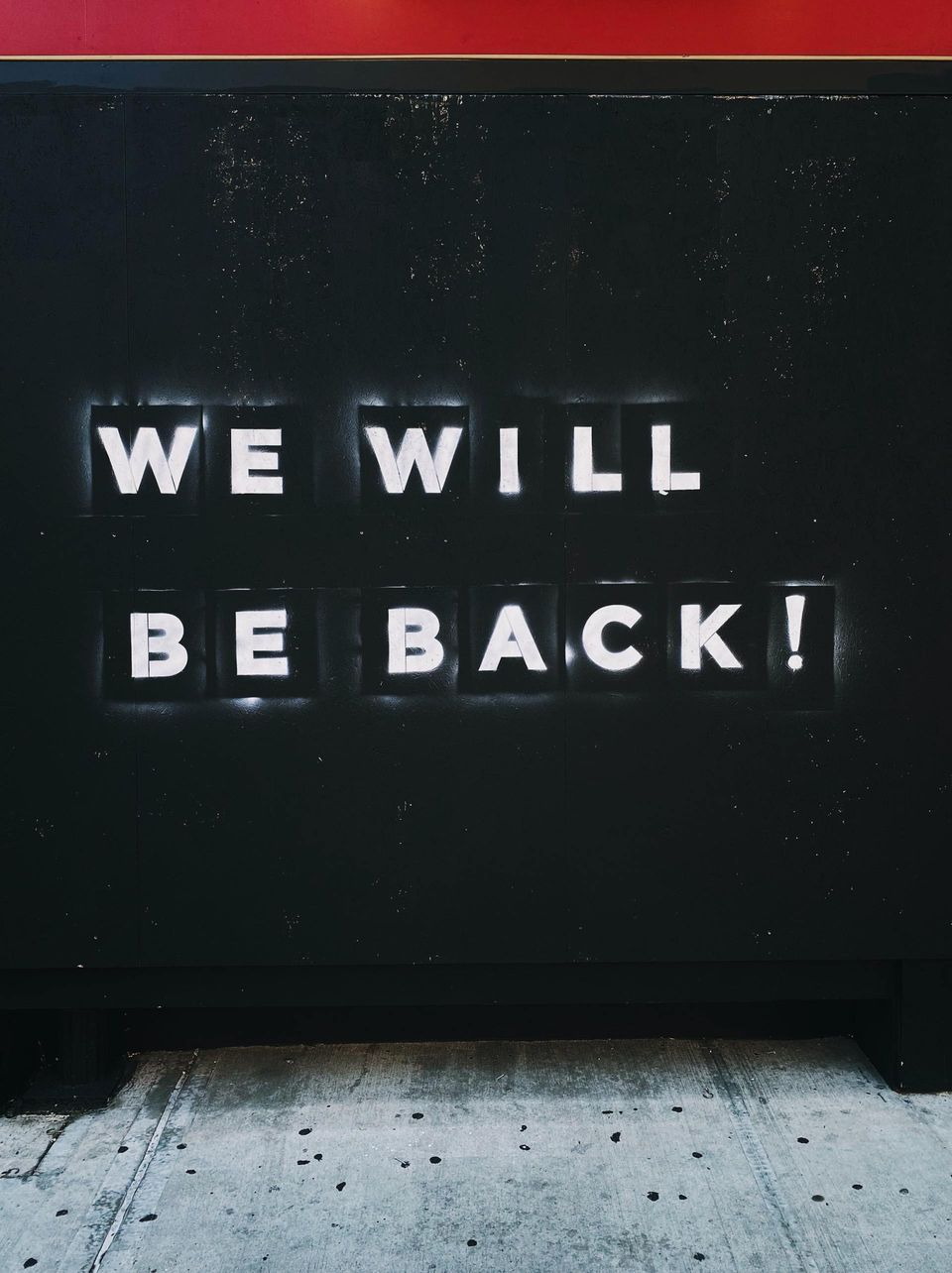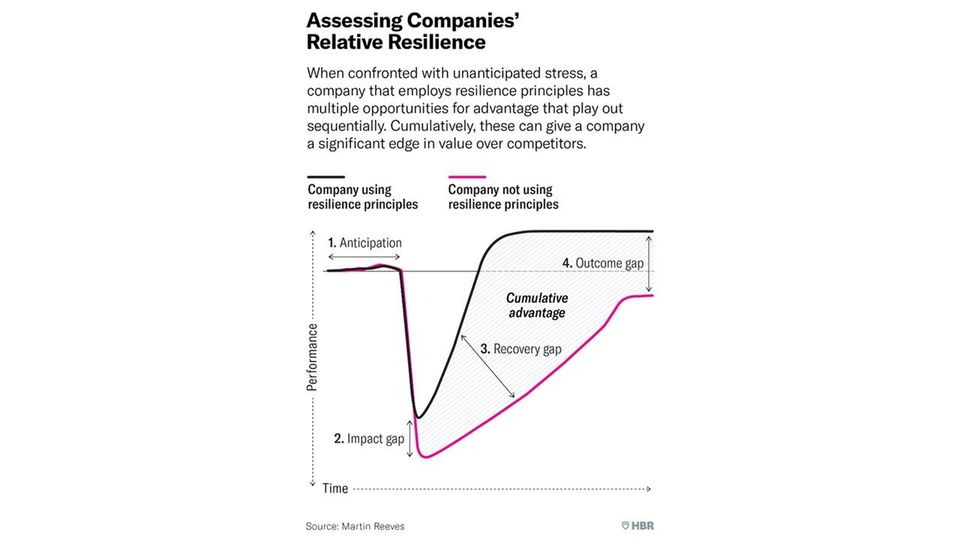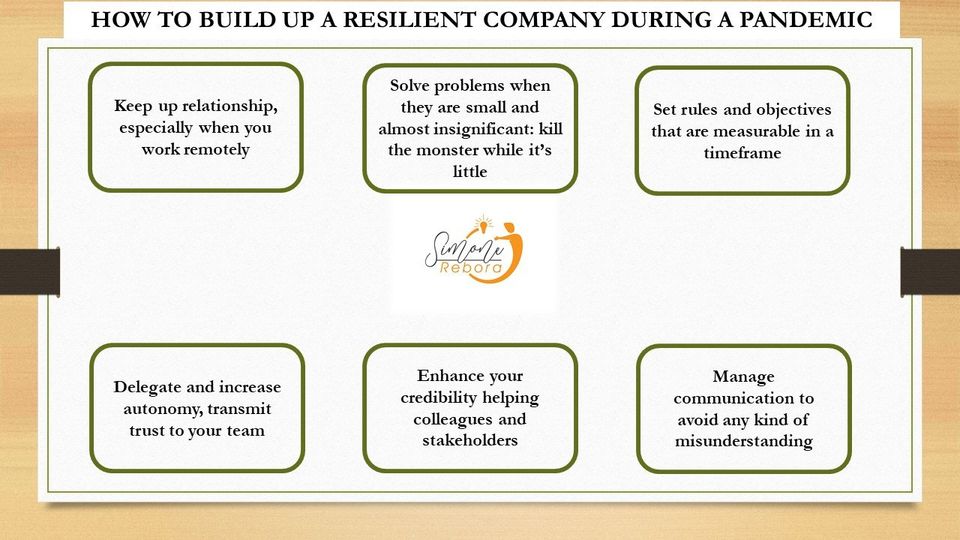THE POWER OF RESILIENCE DURING COVID-19 OUTBREAK
Simone Rebora • 20 luglio 2020
Resilient leaders use crises to change organizational mindsets, address uncertainties and invest in building trust to develop a recovery program that will serve as a solid foundation for the post-COVID future.

In the business world, particularly during Covid-19 pandemic, the concept of organizational
resilience
has emerged as a relatively new trend and has often been used to refer to (a) the ability of an organisation to absorb effort and to preserve (or improve) how it functions despite adversity or (b) the ability of the organisation to recover and react from unpleasant events. We should note the overlap with the concept of “organisational agility” that Sharifi and Zhang (1999) defined as the ability to address different challenges to survive unprecedented threats to the business environment and to benefit from change as an opportunity.
Generally, resilience begins with a huge number of bad emotions, almost a sort of unpredictable flow of negative news increasing day-by-day. The only way to use this bucket of emotions and empathize with the sense of resilience is to understand that they all serve you and you can learn from them, realizing that you could feel them as a guideline and a support system. Management guru Tony Robbins, in his book "Awaken the Giant Within", says that
instead of calling them negative emotions, let's call them Action Signals, in which the purpose is to use your bad feeling not as your enemy, but as your ally.
From my perspective, Action Signals must be sized and weighted in order to ease the action right now, not tomorrow, during the difficult period. Recently, I have read interesting articles which talked about resilience and how apply it in a company: curiously, resilience in an organization can be meant as capacity to absorb stress, recover critical functionality, and thrive in challenging circumstances. In a nutshell,
being a high performer under extreme pressure. Nevertheless, isn’t it difficult circumstances that can increase anxiety and insecurity? Then, it is essential to implement series of rules that can help everyone to recover after failing and become stronger than before, especially learning from previous experiences.
MAXIMIZING RESILIENCE IN COMPANIES
Valuable insights come from one of the last article published in Harvard Business Review entitled “ A Guide to Building a More Resilient Business” where they identified 6 imperatives with which companies can structure their assets and decision-making processes, making the most of resilience. For me, I think that 3 of the points in particular, when combined with some of the points from McKinsey’s “Five actions to boost your sales organization’s resilience”, together create a reliable guide for how to maximise resilience. Here below my 6 personal tips to enhance organisational resilience:
1. Adaptability
is the ability to evolve through trial and error.
2. Prudence
involves operating on the precautionary principle that if something could plausibly happen, it eventually will.
3. Integration
is the alignment of a company’s goals and activities with those of broader systems.
4. Flexibility
resets and adjusts expectations around scenarios; COVID-19 has had a significant impact on organizations.
5. Investment
in training employees to increase their capabilities for the recovery.
6. Vision
provides leadership the capacity to anticipate events and assess potential threats of the company
In addition, companies can increase their resilience through collaboration
with other players. Business ecosystems, such as digital platforms, can increase their collective resilience through access to new capabilities, through greater flexibility and by reducing the fixed cost of entry into companies where assets can now be shared. Shared platforms essentially create "real" insurance against the unexpected through investment in shared execution, adaptation and innovation mechanisms.
THE VALUE OF RESILIENCE
When comparing two companies of differing tolerance to stress, the company that applies resilience imperatives has multiple advantages that play out sequentially, as can be seen by this great illustration from the Harvard Business Review (see below the illustration):
- First step is an anticipation benefit, which is the ability to recognize and anticipate threats faster. No further positive performance is achieved at this stage.
- Second step is an impact benefit, that is the capacity to stand out to the big shock.
- Third step is a recovery trend, which could have a positive rebound from the initial shock
- Fourth step is the outcome benefit that represents the better company health after the first negative impact
The recovery gap that you can see in the chart generates a meaningful difference in value between companies that apply resilience rules and those that do not. It will be curious to see how different sectors and companies could react in a recovery phase and with which different speed.
BUILDING UP A RESILIENT COMPANY
Before shaping a resilient company, it’s essential (as always) to convey this feeling to all stakeholders that work and try to tackle challenges and opportunities. I’ve identify 6 key takeaways that, in my opinion, everyone should try to apply in its company.
1) Keep up relationship, especially when you work remotely
2) Delegate and increase autonomy, transmit trust to your team
3) Manage communication
to avoid any kind of misunderstanding
4) Set rules and objectives
that are measurable in a timeframe
5) Enhance your credibility
helping colleagues and stakeholders
6) Solve problems when they are small
and almost insignificant: kill the monster while it’s little
PRACTICE POSITIVE THINKING
It's human nature to think negatively in a challenging situation, especially an unpredictable one. The research is clear that positive thinking and self-talk are not only better for our overall health, but they can influence our overall outlook on life. Here's some of the positive thinking reactions you can practice immediately in the face of adversity:
- Think step by step in a short-term. By acknowledging that negative events are temporary, changeable, and associated only with the situation, you're adapting to a more resilient outlook. Keep your perspective tight and focus on the here-and-now without allowing yourself to believe that the circumstances will extend into the long-term.
- Focus close to home
(on yourself). What I mean by this is to focus only on yourself and what you can do to change the situation. Comparing yourself to others and their circumstances will only create negative feelings, especially if their situations are not as difficult as yours. And this perspective will not result in any productive outcomes.
- Keep the situation in perspective. Ask yourself what the worst-case outcome of this setback could be. It's not an uncommon tendency for people to blow things out of proportion. Depending on the severity of the setback, this often makes things worse.
- Talk positive and select effective words.
The words you use, internally and externally, can influence your mindset; realize the power that your words command if you simply choose them wisely. Change your habitual vocabulary and try to replace “irritated --> stimulated”, “failure --> temporary defeat”, “failure --> learning”, “depressed --> not on top of it”, “terrible --> different”.
Positive self-talk and perspective are directly related to positive emotions. If you prefer to write your language down, replay it in your head, or speak it out loud with close friends, keep it all optimistic.
What do you think?
Let me know your feedback!
--------------------------------------------------------------------------------------------------------------------
Nel mondo del business, in particolare durante la pandemia di Covid-19, il concetto di resilienza
organizzativa è emerso come una tendenza relativamente nuova ed è stato spesso utilizzato per riferirsi:
(a) alla capacità di un'organizzazione di assorbire gli sforzi e di preservare (o migliorare) il suo funzionamento nonostante le avversità
(b) alla capacità dell'organizzazione di recuperare e reagire a eventi spiacevoli. Dovremmo notare la sovrapposizione con il concetto di "agilità organizzativa" che Sharifi e Zhang (1999) hanno definito come la capacità di affrontare diverse sfide per sopravvivere a minacce senza precedenti per l'ambiente aziendale e per beneficiare del cambiamento come opportunità.
In generale, la resilienza inizia con un numero enorme di emozioni "cattive", quasi una sorta di flusso imprevedibile di notizie negative che aumentano giorno dopo giorno. L'unico modo per usare questo bucket di emozioni ed entrare in empatia con il senso di resilienza è capire che tutte queste sensazioni servono e puoi imparare da loro, realizzando che puoi sentirle come una linea guida e un sistema di supporto. Il guru del management Tony Robbins, nel suo libro "Awaken the Giant Within", dice che invece di chiamarle emozioni negative, le puoi chiamare Segnali d'Azione, in cui lo scopo è quello di usare le vostre sensazioni negative non come nemiche, ma come vostre alleate.
Dal mio punto di vista, i Segnali d'Azione devono essere dimensionati e ponderati per facilitare l'azione immediata, non domani, ma subito. Recentemente, ho letto interessanti articoli che parlavano della resilienza e di come applicarla in un'azienda: curiosamente, la resilienza in un'organizzazione può essere intesa come capacità di assorbire lo stress, recuperare le funzionalità critiche e prosperare in circostanze difficili. In poche parole, essere un high performer sotto estrema pressione. Tra l'altro, non sono le circostanze difficili che possono aumentare l'ansia e l'insicurezza? Allora, è essenziale implementare una serie di regole che possano aiutare tutti a recuperare dopo aver fallito e diventare più forti di prima, soprattutto imparando dalle esperienze precedenti.
MASSIMIZZARE LA RESILIENZA NELLE AZIENDE
Preziosi insights provengono da uno degli ultimi articoli pubblicati su Harvard Business Review intitolato "A Guide to Building a More Resilient Business", in cui si individuano 6 pillars con cui le aziende possono strutturare i propri asset e i processi decisionali, sfruttando al meglio la resilienza. Dal mio punto di vista, ho analizzato 3 punti che io ritengo fondantali, i quali uniti altri 3 di un articolo di McKinsey "Five actions to boost your sales organization's resilience" creano una guida affidabile su come massimizzare la resilienza. Qui sotto i miei 6 consigli personali per migliorare la resilienza dell'organizzazione:
1. L'adattabilità
è la capacità di evolvere per tentativi ed errori.
2. La prudenza
implica operare in base al principio di precauzione che se qualcosa potrebbe plausibilmente accadere, alla fine accadrà.
3. L'integrazione
è l'allineamento degli obiettivi e delle attività di un'azienda con quelli di sistemi più ampi.
4. La flessibilità
azzera e regola le aspettative intorno agli scenari; COVID-19 ha avuto un impatto significativo sulle organizzazioni.
5. Investimento
nella formazione dei dipendenti per aumentare le loro capacità di recupero.
6. La visione
fornisce alla leadership la capacità di anticipare gli eventi e di valutare le potenziali minacce dell'azienda.
Inoltre, le aziende possono aumentare la loro resilienza attraverso la collaborazione
con altri settori. Gli ecosistemi aziendali, come le piattaforme digitali, possono aumentare la resilienza collettiva attraverso l'accesso a nuove capacità, attraverso una maggiore flessibilità e riducendo il costo fisso di ingresso nelle aziende dove gli asset possono ora essere condivisi. Le piattaforme condivise creano essenzialmente una "vera" assicurazione contro l'imprevisto attraverso l'investimento in meccanismi di esecuzione condivisa, adattamento e innovazione.
IL VALORE DELLA RESILIENZA
Quando si confrontano due aziende che reagiscono in maniera diversa allo stress, l'azienda che applica gli imperativi di resilienza ha molteplici vantaggi che si svolgono in sequenza, come si può vedere dalla chart della Harvard Business Review qui sotto:
- Il primo step è un vantaggio di anticipazione, ovvero la capacità di riconoscere e anticipare le minacce più velocemente. In questa fase non si ottengono ulteriori risultati positivi.
- Il secondo step è un beneficio di impatto, ovvero la capacità di distinguersi dal grande shock.
- Il terzo step è un trend di recupero, che potrebbe avere un rimbalzo positivo dallo shock iniziale
- Il quarto step è il beneficio di risultato che rappresenta il miglioramento della salute dell'azienda dopo il primo impatto negativo
Il gap di recupero che si può vedere nel grafico genera una significativa differenza di valore tra le aziende che applicano le regole di resilienza e quelle che non le applicano. Sarà curioso vedere come diversi settori e aziende potrebbero reagire in una fase di recupero e con quale diversa velocità.
COSTRUIRE UN'AZIENDA RESILIENTE
Prima di dare forma a un'azienda resiliente, è essenziale (come sempre) trasmettere questa sensazione a tutti gli stakeholder che lavorano e cercano di affrontare sfide e opportunità. Ho individuato 6 punti chiave che, a mio avviso, tutti dovrebbero cercare di applicare nella propria azienda.
1) Mantenere le relazioni, soprattutto quando si lavora a distanza
2) Delegare e aumentare l'autonomia, trasmettere fiducia al vostro team
3) Gestire la comunicazione
per evitare qualsiasi tipo di malinteso
4) Fissare regole e obiettivi
misurabili in un arco di tempo
5) Aumentare la vostra credibilità
aiutando i colleghi e gli stakeholder
6) Risolvere i problemi quando sono piccoli
e quasi insignificanti: uccidere il mostro finché è piccolo
ALLENA IL PENSIERO POSITIVO
È nella natura umana pensare negativamente in una situazione difficile, soprattutto se imprevedibile. La ricerca è chiara: il pensiero positivo e l'autoconsiderazione non solo sono migliori per la nostra salute generale, ma possono influenzare la nostra visione complessiva della vita. Ecco alcune delle reazioni di pensiero positivo che si possono praticare immediatamente di fronte alle avversità:
- Pensare step by step in un breve periodo. Riconoscendo che gli eventi negativi sono temporanei, mutevoli e associati solo alla situazione, ti stai adattando a una prospettiva più elastica. Mantenete la vostra prospettiva e concentratevi sul qui e ora, senza permettervi di credere che le circostanze si estenderanno a lungo termine.
- Concentratevi su voi stessi. Con questo intendo dire che dovete concentrarvi solo su voi stessi e su ciò che potete fare per cambiare la situazione. Confrontarsi con gli altri e le loro circostanze creerà solo sentimenti negativi, soprattutto se le loro situazioni non sono difficili come la vostra. E questa prospettiva non porterà ad alcun risultato produttivo.
- Mantenete la situazione in prospettiva.
Chiedetevi quale potrebbe essere l'esito peggiore di questa battuta d'arresto. Non è una tendenza insolita per le persone gonfiare le cose a dismisura. A seconda della gravità della battuta d'arresto, questo spesso peggiora le cose.
- Parlate in modo positivo e scegliete parole efficaci. Le parole che usate, internamente ed esternamente, possono influenzare la vostra mentalità; ragionate sul potere che le vostre parole hanno e sceglietele semplicemente con saggezza. Cambiate il vostro vocabolario abituale e cercate di sostituire ad esempio "irritato --> stimolato", "fallimento --> sconfitta temporaneo", "fallimento --> apprendimento", "depresso --> non al massimo", "terribile --> diverso".
Un positivo self-talk e la propria prospettiva sono direttamente collegate alle emozioni positive. Prima di affrontare qualsiasi situazione, scrivetevi il discorso, riascoltatelo nella vostra testa, o ripetetelo ad alta voce con gli amici più cari, ma soprattutto mantenetelo sempre ottimistico.
Cosa ne pensate?
Fatemi avere il vostro feedback!

Over the past months, through my LinkedIn series “Chapter: The Promise Journey,” I have explored how AI is weaving a transformative red thread throughout pharma’s complex ecosystem. This article offers a comprehensive summary and reflections on the early stages of this journey, highlighting the immense promise AI holds, and the leadership and cultural shifts required to fully realize its potential.

As artificial intelligence reshapes the pharmaceutical landscape, I am compelled to synthesize the key milestones and reflections from my LinkedIn series, The Promise AI Journey, into this first comprehensive summary. This article distills lessons from building AI roadmaps, navigating Pharma’s unique challenges, and envisioning a future where AI accelerates both innovation and ethical responsibility.



